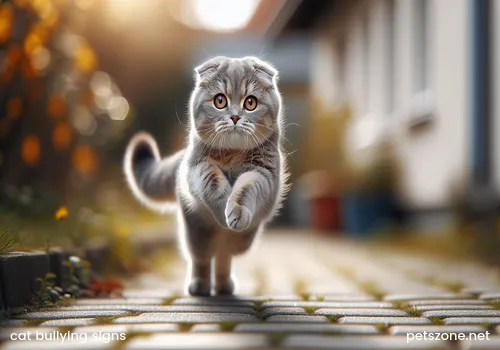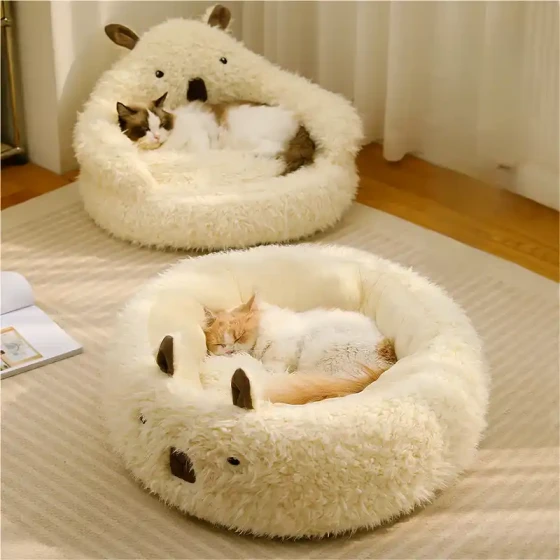The表现of a Cat Bullying Another Cat_How to Identify Bullying Behavior Between Cats
Sometimes, you may find that the two cats at home do not coexist as peacefully as you imagined; instead, one cat "bullies" the other. This behavior not only stresses the bullied cat but may also affect the harmony of the entire household. Understanding the manifestations of bullying behavior between cats and how to identify them is crucial for "pet parents" in multi-cat households. Cat bullying is not always obvious physical conflict; sometimes they bully their companions in more covert ways.

What Are the Manifestations of Cat Bullying Behavior?
Bullying behavior between cats can take many forms; some are obvious attacks, while others are more hidden. Understanding these signs helps us intervene timely and prevent escalation.
1. Physical Conflicts and Attacks
This is the easiest bullying behavior to recognize. When one cat bullies another, the following physical conflicts and attacks may occur:
- Chasing and ambushing: One cat may repeatedly chase another, or hide in a corner and suddenly jump out to ambush.
- Fighting: Including scratching, biting, and kicking. In real fights, cats’ bodies stiffen, tails may be upright or tucked between the legs, ears pinned back or flattened, and they emit hissing or screaming sounds.
- Blocking movement: The bullying cat may block doorways or hallways to prevent the other cat from passing.
- Dominant body posture: Some cats attempt to appear larger and more threatening by straightening their bodies, raising fur (commonly called "piloerection"), and pointing ears forward.
2. Resource Control and Competition
Cats have a strong sense of territoriality over resources, including food, water, litter boxes, resting areas, toys, and even the owner's attention. Bullying cats may bully others by controlling access to these resources.
- Occupying food and water bowls: Preventing another cat from approaching.
- Monopolizing litter boxes: Blocking other cats from using the litter box, which may lead the bullied cat to eliminate outside the box.
- Taking over resting areas: Occupying places favored by other cats for resting or sleeping.
- Exclusively owning toys or scratching posts: Preventing others from playing or scratching.
- Competing for the owner's attention: Pushing aside other cats, hissing, or using their body to block others to draw the owner’s focus.
3. Intimidation and Scaring
Besides direct physical conflict, cats may use some "soft violence" to bully companions:
- Long stare: Prolonged direct eye contact can be seen as provocation or threat between cats.
- Low growls and hissing: Threatening sounds to warn or scare another cat.
- Tail flicking: Forceful tail movement can also indicate tension or dissatisfaction.
- Stalking and monitoring: Repeatedly following and watching another cat to make them feel uneasy.
How to Identify Bullying Behavior Between Cats?
Distinguishing between play and bullying is key to identifying bullying behavior. Cats are usually relaxed during play, actions are reciprocal, even if pouncing occurs, they do not use real force, and may groom or snuggle afterward. Bullying behavior, however, is accompanied by tense, fearful, or aggressive body language and sounds.
Here are some key points to identify cat bullying behavior:
1. Observe Body Language
Pay attention to cats’ posture, ears, eyes, and tail state during interactions.
- Ears: If ears are pinned back or flat against the head, it may indicate fear, tension, or aggression.
- Eyes: Dilated pupils may signal fear or excitement. Prolonged staring at another cat is also a sign.
- Fur: Raised fur on the back or tail (piloerection) usually indicates tension or threat.
- Tail: Rapid and forceful tail flicking or tail tucked between legs may express negative emotions.
- Body posture: Stiff body, lowered posture readying for attack, or arched back trying to appear larger are signals of bullying or readiness to fight. Bullied cats may try to curl up to appear smaller or lean against walls.
2. Listen to Sounds
Cats are usually quiet or meow during play. Continuous low growls, hisses, roars, or screams likely indicate fighting or bullying.
3. Observe Interaction Patterns
- One-sided attacks: If the same cat always chases or attacks another, while the bullied cat constantly dodges or tries to escape, bullying is likely.
- Bullying cat’s reactions: The bullied cat may show fear, hiding, loss of appetite, inappropriate elimination, signs of stress, or even health issues like over-grooming leading to hair loss, diarrhea, or vomiting.
- Post-interaction behavior: If after a fight the cats immediately separate and avoid each other instead of continuing to groom or interact like after play, the interaction was negative.
4. Consider Environmental Changes
Many times, bullying behavior relates to environmental changes or resource shortages. For example, introducing a new cat, moving, rearranging furniture, schedule changes, or insufficient litter boxes and food bowls can increase stress and conflicts. Observing the behaviors above under these circumstances raises the likelihood of bullying.
Why Do Cats Bully Their Companions?
Understanding the reasons behind cat bullying helps us take effective measures.
- Territorial awareness: Cats are very territorial and will defend their territory and resources. Conflicts may arise when new cats join or cats reach sexual maturity due to territorial disputes.
- Insecurity and stress: New environments, new family members (human or pets), schedule changes, loud noises, etc., can make cats feel stressed and insecure, leading to aggression. Bullied cats may respond defensively out of fear.
- Resource competition: As mentioned, competition over food, water, litter boxes, resting areas, and owner's attention commonly causes bullying.
- Boredom: Sometimes cats bully others simply because they are bored and need to expend excess energy.
- Lack of socialization: Cats poorly socialized during kittenhood may not know how to properly interact with other cats and show inappropriate aggression when grown.
- Health issues: Physical discomfort, pain, or illness can alter a cat’s temperament, making them irritable or aggressive. If behavior suddenly changes, consult a vet to rule out health problems.
- Personality mismatch: Some cats naturally have incompatible personalities and struggle to get along peacefully.
How to Help Cats Resolve Bullying Problems?
Resolving bullying between cats requires patience and proper methods.
1. Isolation and Reintroduction
If bullying has already occurred, first completely separate the two cats to different rooms to avoid physical conflict and ongoing tension. During isolation, you can gradually familiarize them with each other's scent by exchanging items like blankets or toys bearing the other's scent.
After a period of isolation, try gradual reintroduction. For example, feed them on opposite sides of a door gap so they associate the other's presence with positive feeding experiences; or let them interact visually through glass doors or gates while offering treats or toys to build positive associations. Monitor their reactions; if tension or aggression appears, separate immediately and revert to the previous step.
2. Optimize Living Environment
Providing ample resources and a more comfortable environment helps ease tension and reduce conflicts.
- Provide sufficient resources: Ensure each cat has its own food bowl, water bowl, litter box, scratching post, and resting area. Follow the “N+1” rule for litter boxes (number of cats plus one).
- Increase vertical space: Cats enjoy observing from heights; provide cat trees, wall shelves, and other vertical spaces to expand their activity areas and sense of security.
- Set up hiding spaces: Give cats enough places to hide and rest, like boxes or cat beds, so they feel safe.
- Enrich the environment: Offer various toys and puzzle feeders to boost activity and mental stimulation, helping them burn energy and reduce boredom.
3. Reduce Stress
identified and addressed.
- Maintain stable routines: Cats prefer regularity; keep feeding, play, and interaction times consistent.
- Minimize environmental changes: Avoid frequent furniture moves or new stimuli introductions. If changes are necessary, do so gradually.
- Use cat pheromone products: Sprays or plug-in diffusers of cat pheromones help relieve tension and anxiety at home.
- Increase one-on-one interaction time with each cat: Ensure every cat receives owner attention and companionship to reduce competition and conflicts.
4. Seek Professional Help
If bullying behavior is severe or persistent, consult a vet or professional cat behaviorist. They can help identify root causes and provide personalized behavior modification plans, and may recommend medication to alleviate anxiety or aggression.
Frequently Asked Questions
-
What is the difference between cats fighting and playing?
Cats are usually relaxed during play, movements are reciprocal, emitting fewer threatening sounds, and groom or snuggle afterward. Fighting or bullying involves stiff bodies, pinned-back ears, dilated pupils, raised fur, and hissing or screaming sounds, with cats avoiding each other after the interaction. -
Why does my cat bully the new cat?
Resident cats may view newcomers as threats to their territory, resources, or owner’s attention, resulting in bullying. The arrival of a new cat can stress the resident cats. -
What are the signs exhibited by bullied cats?
Bullied cats may become timid, hide, lose appetite, eliminate inappropriately, over-groom leading to hair loss, or develop health problems. They often try to avoid contact with the bully. -
How to prevent cat bullying?
Use appropriate methods from the start when introducing new cats, gradually familiarize them with each other’s scent and presence. Ensure ample resources, enrich the environment, reduce stress, and observe interactions closely to detect and address issues promptly.
Summary
Bullying between cats is a problem that requires attention. As responsible "pet parents," we must learn to recognize these behaviors, understand their causes, and take effective measures to help cats build harmonious "cat relationships." By providing sufficient resources, optimizing the living environment, reducing stress, and seeking professional help when necessary, we can create a safe, comfortable, and loving home for cats to live happily. Remember, each cat is an independent individual, and their interaction patterns require our patient observation and guidance.





